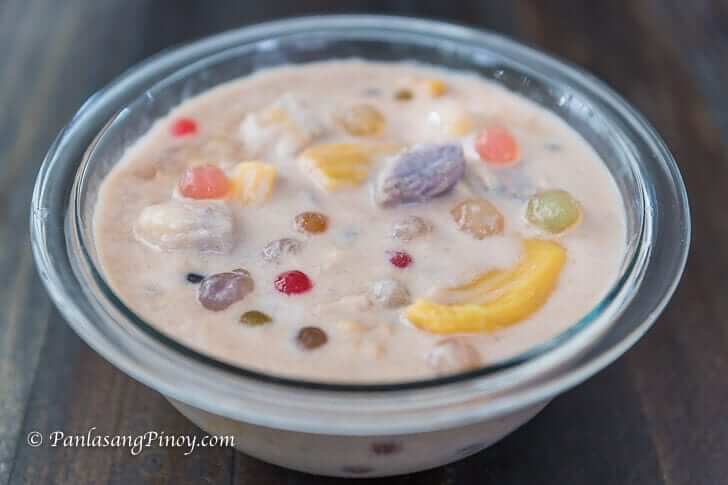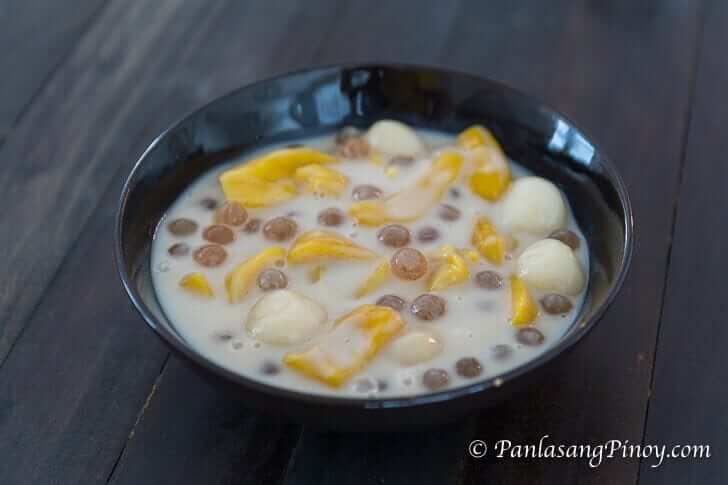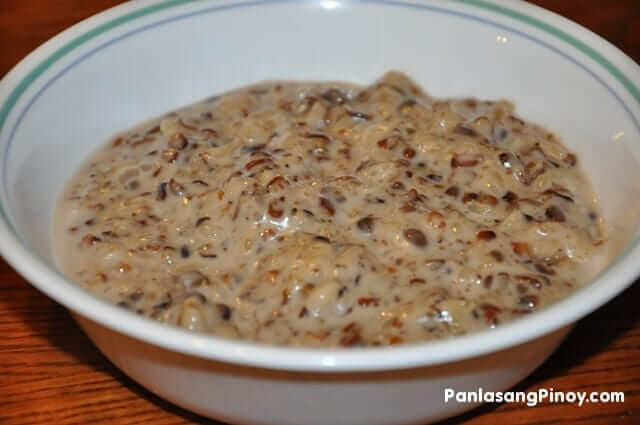Ginataang Halo-halo Recipe (Binignit)
Ginataang Halo-halo is a Filipino dessert dish. This is composed of different tubers such as sweet potato, purple yam, and taro root. Aside from the tubers, other ingredients include plantains, tapioca pearls, and glutinous rice balls (bilo-bilo).
Dishes that are cooked in coconut milk are locally called “Ginataan”. This word was derived from the root word “gata”, which means coconut milk. On the other hand, the word “Halo-halo” refers to the combination of different components or ingredients that were used to complete the dish; this also refers to a popular Filipino summer dessert wherein several sweet ingredients are combined with crushed iced, evaporated milk, leche flan, and ube halaya.
Aside from being a dessert dish, Ginataang Halo-halo is also served during meryenda (mid afternoon snack).
I like the flavor and texture of this dessert dish: the sweetness is just about right while the soft and chewy texture of the components makes eating more enjoyable.
This post may contain affiliate links. Please read our disclosure policy.
Ginataang Halo-halo (also known as binignit) is a Filipino dessert dish. This is composed of different tubers such as sweet potato, purple yam, and taro root. Aside from the tubers, other ingredients include plantains, tapioca pearls, and glutinous rice balls (bilo-bilo). This dish is also known as binignit in some parts of the Philippines.

Dishes that are cooked in coconut milk are locally called “Ginataan”. This word was derived from the root word “gata”, which means coconut milk. On the other hand, the word “Halo-halo” refers to the combination of different components or ingredients that were used to complete the dish; this also refers to a popular Filipino summer dessert wherein several sweet ingredients are combined with crushed iced, evaporated milk, leche flan, and ube halaya.
Aside from being a dessert dish, Ginataang Halo-halo is also served during meryenda (mid afternoon snack).
I like the flavor and texture of this dessert dish: the sweetness is just about right while the soft and chewy texture of the components makes eating more enjoyable.
Do you like Ginataang Halo-halo too? What do you like most about this dish?
Did you make this? If you snap a photo, please be sure tag us on Instagram at @panlasangpinoy or hashtag #panlasangpinoy so we can see your creations!

Ginataang Halo-halo Recipe (Binignit)
Ingredients
- 1 1/2 cups sweet potatoes kamote, diced
- 1 cup taro roots gabi, diced
- 1 1/2 cups purple yam
- 1 1/4 cup plantains saging na saba, diced
- 1 cup ripe jackfruit langka, sliced
- 2 cups small tapioca pearls cooked
- 12 to 20 pieces glutinous rice balls bilo-bilo
- 1 cup granulated white sugar
- 3 1/2 cups coconut milk
- 2 cups water
Instructions
- Pour water in a large cooking pot and apply heat. Let boil.
- Add 1 3/4 cups of coconut milk then wait until it re-boils.
- Put-in the sweet potatoes, purple yam, and taro roots and simmer for 8 minutes.
- Pour-in the remaining coconut milk, sugar, and glutinous rice balls then stir. Simmer for 7 minutes.
- Add the plantains then cook for an additional 2 minutes.
- Put-in the jack fruit and cook for 2 minutes more.
- Slowly slide-in the cooked tapioca pearls then stir. Simmer for 1 minute.
- Turn off heat and transfer to a serving plate.
- Serve either hot or cold. Share and enjoy!
Nutrition Information
Watch the Video on How to Cook Ginataang Halo-halo Recipe (Binignit)




Marianita Workman says
This is another way to enhance bilo bilo flavor. Put at least a teaspoon or two of salt and use a coconut cream with a small amount of glutinous rice flour for thickener toward the end of cooking. Stir while pouring the thickener to avoid lumps. Sounds complicated but the effort is worth it!
Donald Ethan Roma says
That food is mostly known as “BINIGNIT” in Davao City.
Alarie says
Thanks for the info Victor. This will be my project tonight 🙂
RDT says
this is locally known as “binignit” in our area
Jan says
For how many people is this for?
lhie says
you can buy glutinous rice then add some water to make it bilo bilo…pero madaming water..tantiyahin lang yung tamang na bibilog mo yung glutinous rice..^_^
Jetjet says
Has anybody tried this without or with much less sugar? Just wondering if the natural sugars from the ingredients would be suffice. There is a Japanese restaurant here that makes flan using organic ingredients & much less sugar, but is still very good without going overboard with the sweetness.
mint says
making this right now and will be using 3/4 cup sugar not 1 cup. just to give it enough sweetness. hope it will turn out just as good, thanks for the recipe.